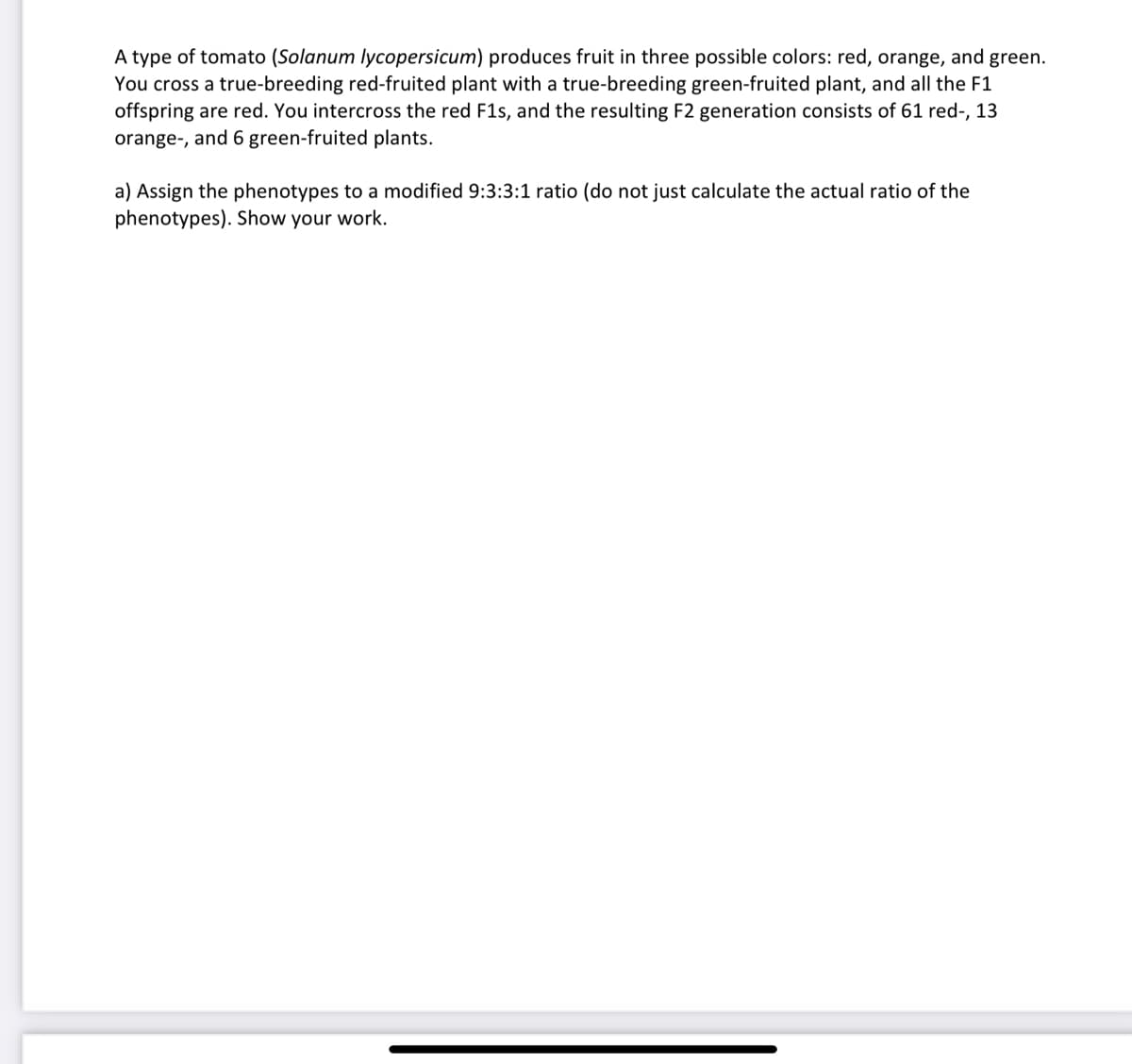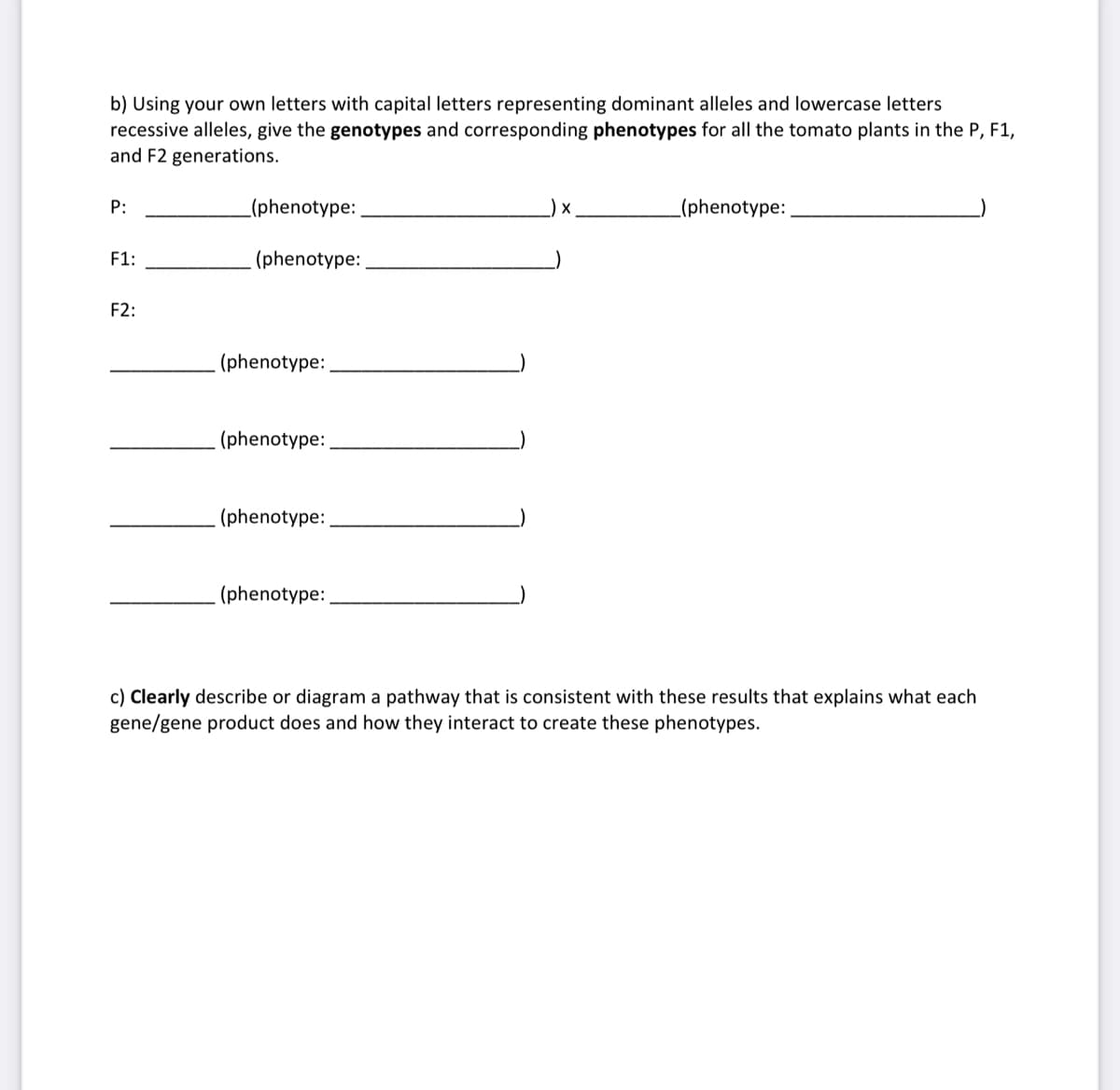A type of tomato (Solanum lycopersicum) produces fruit in three possible colors: red, orange, and green. You cross a true-breeding red-fruited plant with a true-breeding green-fruited plant, and all the F1 offspring are red. You intercross the red F1s, and the resulting F2 generation consists of 61 red-, 13 orange-, and 6 green-fruited plants. a) Assign the phenotypes to a modified 9:3:3:1 ratio (do not just calculate the actual ratio of the phenotypes). Show your work.
A type of tomato (Solanum lycopersicum) produces fruit in three possible colors: red, orange, and green. You cross a true-breeding red-fruited plant with a true-breeding green-fruited plant, and all the F1 offspring are red. You intercross the red F1s, and the resulting F2 generation consists of 61 red-, 13 orange-, and 6 green-fruited plants. a) Assign the phenotypes to a modified 9:3:3:1 ratio (do not just calculate the actual ratio of the phenotypes). Show your work.
Concepts of Biology
1st Edition
ISBN:9781938168116
Author:Samantha Fowler, Rebecca Roush, James Wise
Publisher:Samantha Fowler, Rebecca Roush, James Wise
Chapter8: Patterns Of Inheritance
Section: Chapter Questions
Problem 2ACQ: Figure 8.10 In pea plants, purple flowers (P) are dominant to white (p), and yellow peas (Y) are...
Related questions
Question
It’s the one question but different page. Can you please do it.

Transcribed Image Text:A type of tomato (Solanum lycopersicum) produces fruit in three possible colors: red, orange, and green.
You cross a true-breeding red-fruited plant with a true-breeding green-fruited plant, and all the F1
offspring are red. You intercross the red F1s, and the resulting F2 generation consists of 61 red-, 13
orange-, and 6 green-fruited plants.
a) Assign the phenotypes to a modified 9:3:3:1 ratio (do not just calculate the actual ratio of the
phenotypes). Show your work.

Transcribed Image Text:b) Using your own letters with capital letters representing dominant alleles and lowercase letters
recessive alleles, give the genotypes and corresponding phenotypes for all the tomato plants in the P, F1,
and F2 generations.
P:
(phenotype:
) x
(phenotype:
F1:
(phenotype:
F2:
(phenotype:
(phenotype:
(phenotype:
(phenotype:
c) Clearly describe or diagram a pathway that is consistent with these results that explains what each
gene/gene product does and how they interact to create these phenotypes.
Expert Solution
This question has been solved!
Explore an expertly crafted, step-by-step solution for a thorough understanding of key concepts.
This is a popular solution!
Trending now
This is a popular solution!
Step by step
Solved in 4 steps with 2 images

Recommended textbooks for you

Concepts of Biology
Biology
ISBN:
9781938168116
Author:
Samantha Fowler, Rebecca Roush, James Wise
Publisher:
OpenStax College

Biology (MindTap Course List)
Biology
ISBN:
9781337392938
Author:
Eldra Solomon, Charles Martin, Diana W. Martin, Linda R. Berg
Publisher:
Cengage Learning

Concepts of Biology
Biology
ISBN:
9781938168116
Author:
Samantha Fowler, Rebecca Roush, James Wise
Publisher:
OpenStax College

Biology (MindTap Course List)
Biology
ISBN:
9781337392938
Author:
Eldra Solomon, Charles Martin, Diana W. Martin, Linda R. Berg
Publisher:
Cengage Learning